Hydrothermal Fabrication of GO Decorated Dy2WO6-ZnO Ternary Nanocomposites: An Efficient Photocatalyst for the Degradation of Organic Dye
Abstract
:1. Introduction
2. Materials and Methods
2.1. Preparation of Dy2WO6 (DW)
2.2. Preparation of Dy2WO6-ZnO/GO (DWZG)
2.3. Evaluation of Catalytic Degradation of Pollutants
3. Results and Discussion
3.1. Analysis of Crystal Pattern of the Photocatalysts
3.2. Morphology and Elemental Composition of the Photocatalysts
3.3. Optical Properties by DRS-UV and Raman Spectroscopy
3.4. XPS Analysis
3.5. Estimation of Photodegradation Performance
4. Conclusions
Supplementary Materials
Author Contributions
Funding
Institutional Review Board Statement
Informed Consent Statement
Data Availability Statement
Conflicts of Interest
References
- Pastrana-Martínez, L.M.; Faria, J.L.; Doña-Rodríguez, J.M.; Fernández-Rodríguez, C.; Silva, A.M. Degradation of diphenhydramine pharmaceutical in aqueous solutions by using two highly active TiO2 photocatalysts: Operating parameters and photocatalytic mechanism. Appl. Catal. B Environ. 2012, 113, 221–227. [Google Scholar] [CrossRef]
- Ambigadevi, J.; Kumar, P.S.; Vo, D.V.N.; Haran, S.H.; Raghavan, T.S. Recent developments in photocatalytic remediation of textile effluent using semiconductor based nanostructured catalyst: A review. J. Environ. Chem. Eng. 2021, 9, 104881. [Google Scholar] [CrossRef]
- Fagan, R.; McCormack, D.E.; Dionysiou, D.D.; Pillai, S.C. A review of solar and visible light active TiO2 photocatalysis for treating bacteria, cyanotoxins and contaminants of emerging concern. Mater. Sci. Semicond. Process. 2016, 42, 2–14. [Google Scholar] [CrossRef] [Green Version]
- Hunge, Y.; Yadav, A.; Mathe, V. Oxidative degradation of phthalic acid using TiO2 photocatalyst. J. Mater. Sci. Mater. Electron. 2018, 29, 6183–6187. [Google Scholar] [CrossRef]
- Ali, T.; Hunge, Y.M.; Venkatraman, A. UV assisted photoelectrocatalytic degradation of reactive red 152 dye using spray deposited TiO2 thin films. J. Mater. Sci. Mater. Electron. 2018, 29, 1209–1215. [Google Scholar] [CrossRef]
- Hunge, Y.; Yadav, A.; Mathe, V. Ultrasound assisted synthesis of WO3-ZnO nanocomposites for brilliant blue dye degradation. Ultrason. Sonochem. 2018, 45, 116–122. [Google Scholar] [CrossRef] [PubMed]
- Hoffmann, M.R.; Martin, S.T.; Choi, W.Y.; Bahnemann, D.W. Environmental applications of semiconductor photocatalysis. Chem. Rev. 1995, 95, 69–96. [Google Scholar] [CrossRef]
- Chen, C.C.; Ma, W.H.; Zhao, J.C. Semiconductor-mediated photodegradation of pollutants under visible-light irradiation. Chem. Soc. Rev. 2010, 39, 4206–4219. [Google Scholar] [CrossRef]
- Wang, Y.; Jiang, T.; Meng, D.; Yang, J.; Li, Y.; Ma, Q.; Han, J. Fabrication of nanostructured CuO films by electrodeposition and their photocatalytic properties. Appl. Surf. Sci. 2014, 317, 414–421. [Google Scholar] [CrossRef]
- Chen, Q.; Wang, Y.; Zheng, M.; Fang, H.; Meng, X. Nanostructures confined self-assembled in biomimetic nanochannels for enhancing the sensitivity of biological molecules response. J. Mater. Sci. Mater. Electron. 2018, 29, 19757–19767. [Google Scholar] [CrossRef]
- Lee, D.H.; Kim, J.E.; Han, T.H.; Hwang, J.W.; Jeon, S.; Choi, S.Y.; Hong, S.H.; Lee, W.J.; Ruoff, R.S.; Kim, S.O. Versatile carbon hybrid films composed of vertical carbon nanotubes grown on mechanically compliant graphene films. Adv. Mater. 2010, 22, 1247–1252. [Google Scholar] [CrossRef]
- Özgür, Ü.; Alivov, Y.I.; Liu, C.; Teke, A.; Reshchikov, M.; Doğan, S.; Avrutin, V.; Cho, S.J.; Morkoç, H. A comprehensive review of ZnO materials and devices. J. Appl. Phys. 2005, 98, 041301–0413103. [Google Scholar] [CrossRef] [Green Version]
- Chao, L.C.; Huang, J.W.; Chang, C.W. Annealing effects on the properties of Nd containing ZnO nanoparticles prepared by sol–gel process. Phys. B Condens. Matter. 2009, 404, 1301–1304. [Google Scholar] [CrossRef]
- Wang, R.; Xin, J.H.; Yang, Y.; Liu, V.; Xu, L.; Hu, J. The characteristics and photocatalytic activities of silver doped ZnO nanocrystallites. Appl. Surf. Sci. 2004, 227, 312–317. [Google Scholar] [CrossRef]
- Hunge, Y.; Yadav, A.; Kulkarni, S.; Mathe, V. A multifunctional ZnO thin film-based devices for photoelectrocatalytic degradation of terephthalic acid and CO2 gas sensing applications. Sens. Actuators B Chem. 2018, 274, 1–9. [Google Scholar] [CrossRef]
- Hunge, Y.M. Sunlight assisted photoelectrocatalytic degradation of benzoic acid using stratified WO3/TiO2 thin films. Ceram. Int. 2017, 43, 10089–10096. [Google Scholar] [CrossRef]
- El Bekkali, C.; Bouyarmane, H.; El Karbane, M.; Masse, S.; Saoiabi, A.; Coradin, T.; Laghzizil, A. Zinc oxide-hydroxyapatite nanocomposite photocatalysts for the degradation of ciprofloxacin and ofloxacin antibiotics. Colloids Surf. A Physicochem. Eng. Asp. 2018, 539, 364–370. [Google Scholar] [CrossRef] [Green Version]
- Priyadharsan, A.; Shanavas, S.; Vasanthakumar, V.; Balamuralikrishnan, B.; Anbarasan, P. Synthesis and investigation on synergetic effect of rGO-ZnO decorated MoS2 microflowers with enhanced photocatalytic and antibacterial activity. Colloids Surf. A Physicochem. Eng. Asp. 2018, 559, 43–53. [Google Scholar]
- Menon, N.G.; Tatiparti, S.S.V.; Mukherji, S. Synthesis, characterization and photocatalytic activity evaluation of TiO2–ZnO nanocomposites: Elucidating effect of varying Ti: Zn molar ratio. Colloids Surf. A Physicochem. Eng. Asp. 2019, 565, 47–58. [Google Scholar] [CrossRef]
- Lu, M.Y.; Lu, M.P.; Chung, Y.A.; Chen, M.J.; Wang, Z.L.; Chen, L.J. Intercrossed sheet-like Ga-doped ZnS nanostructures with superb photocatalytic activity and photo response. J. Phys. Chem. C 2009, 113, 12878–12882. [Google Scholar] [CrossRef]
- Wan, Q.; Li, Q.; Chen, Y.; Wang, T.H.; He, X.; Li, J.; Lin, C. Fabrication and ethanol sensing characteristics of ZnO nanowire gas sensors. Appl. Phys. Lett. 2004, 84, 3654–3656. [Google Scholar] [CrossRef] [Green Version]
- Schneider, S.L.; Lim, H.W. A review of inorganic UV filters zinc oxide and titanium dioxide. Photodermatol. Photoimmunol. Photomed. 2019, 35, 442–446. [Google Scholar] [CrossRef] [Green Version]
- Zheng, G.; Shang, W.; Xu, L. Enhanced photocatalytic activity of ZnO thin films deriving from a porous structure. Mater. Lett. 2015, 150, 1–4. [Google Scholar] [CrossRef]
- Nourmohammadi, A.; Rahighi, R.; Akhavan, O.; Moshfegh, A. Graphene oxide sheets involved in vertically aligned zinc oxide nanowires for visible light photoinactivation of bacteria. J. Alloys Compd. 2014, 612, 380–385. [Google Scholar] [CrossRef]
- Balachandran, S.; Swaminathan, M. The simple, template free synthesis of a Bi2S3–ZnO heterostructure and its superior photocatalytic activity under UV-A light. Dalton Trans. 2013, 42, 5338–5347. [Google Scholar] [CrossRef] [PubMed]
- Balachandran, S.; Prakash, N.; Thirumalai, K.; Muruganandham, M.; Sillanpää, M.; Swaminathan, M. Facile construction of heterostructured BiVO4–ZnO and its dual application of greater solar photocatalytic activity and self-cleaning property. Ind. Eng. Chem. Res. 2014, 53, 8346–8356. [Google Scholar] [CrossRef]
- Song, S.; Zhang, Y.; Xing, Y.; Wang, C.; Feng, J.; Shi, W.; Zheng, G.; Zhang, H. Rectangular AgIn(WO4)2 nanotubes: A promising photoelectric material. Adv. Funct. Mater. 2008, 18, 2328–2334. [Google Scholar] [CrossRef]
- Zhang, L.W.; Wang, Y.J.; Cheng, H.Y.; Yao, W.Q.; Zhu, Y.F. Synthesis of porous Bi2WO6 thin films as efficient visible-light-active photocatalysts. Adv. Mater. 2009, 21, 1286–1290. [Google Scholar] [CrossRef]
- Rahman, M.M.; Balkhoyor, H.B.; Asiri, A.M. Removal of a melamine contaminant with Ag-doped ZnO nanocomposite materials. New J. Chem. 2019, 43, 18848–18859. [Google Scholar] [CrossRef]
- Kerli, S. Boron-doped cobalt oxide thin films and its electrochemical properties. Mod. Phys. Lett. B 2016, 30, 1650343. [Google Scholar] [CrossRef]
- Raja, A.; Selvakumar, K.; Swaminathan, M.; Kang, M. Redox additive based rGO-Dy2WO6-ZnO nanocomposite for enhanced electrochemical supercapacitor applications. Synth. Met. 2021, 276, 116753. [Google Scholar] [CrossRef]
- Stankovich, S.; Dikin, D.A.; Dommett, G.B.; Kohlhaas, K.M.; Zimney, E.J.; Stach, E.A.; Piner, R.D.; Nguyen, S.T.; Ruoff, R.S. Graphene-based composite materials. Nature 2006, 442, 282–286. [Google Scholar] [CrossRef]
- Geim, A.K. Graphene: Status and prospects. Science 2009, 324, 1530–1534. [Google Scholar] [CrossRef] [Green Version]
- Arunpandian, M.; Selvakumar, K.; Raja, A.; Rajasekaran, P.; Thiruppathi, M.; Nagarajan, E.R.; Arunachalam, S. Fabrication of novel Nd2O3/ZnO-GO nanocomposite: An efficient photocatalyst for the degradation of organic pollutants. Colloids Surf. A Physicochem. Eng. Asp. 2019, 567, 213–227. [Google Scholar] [CrossRef]
- Arunpandian, M.; Selvakumar, K.; Raja, A.; Thiruppathi, M.; Rajasekaran, P.; Rameshkumar, P.; Nagarajan, E.R.; Arunachalam, S. Development of novel Nd2WO6/ZnO incorporated on GO nanocomposite for the photocatalytic degradation of organic pollutants and biological studies. J. Mater. Sci. Mater. Electron. 2019, 30, 18557–18574. [Google Scholar] [CrossRef]
- Basumatary, B.; Basumatary, R.; Ramchiary, A.; Konwar, D. Evaluation of Ag@TiO2/WO3 heterojunction photocatalyst for enhanced photocatalytic activity towards methylene blue degradation. Chemosphere 2022, 286, 131848. [Google Scholar] [CrossRef]
- Yulizar, Y.; Apriandanu, D.O.B.; Surya, R.M. Fabrication of novel SnWO4/ZnO using Muntingia calabura L. leaf extract with enhanced photocatalytic methylene blue degradation under visible light irradiation. Ceram. Int. 2022, 48, 3564–3577. [Google Scholar]
- George, A.; Raj, D.M.A.; Venci, X.; Raj, A.D.; Irudayaraj, A.A.; Josephine, R.; Sundaram, S.J.; Al-Mohaimeed, A.M.; Al Farraj, D.A.; Chen, T.W. Photocatalytic effect of CuO nanoparticles flower-like 3D nanostructures under visible light irradiation with the degradation of methylene blue (MB) dye for environmental application. Environ. Res. 2022, 203, 111880. [Google Scholar] [CrossRef]
- Perumal, V.; Inmozhi, C.; Uthrakumar, R.; Robert, R.; Chandrasekar, M.; Mohamed, S.B.; Honey, S.; Raja, A.; Al-Mekhlafi, F.A.; Kaviyarasu, K. Enhancing the photocatalytic performance of surface-Treated SnO2 hierarchical nanorods against methylene blue dye under solar irradiation and biological degradation. Environ. Res. 2022, 209, 112821. [Google Scholar] [CrossRef] [PubMed]
- Mahanta, U.; Khandelwal, M.; Deshpande, A.S. TiO2@SiO2 nanoparticles for methylene blue removal and photocatalytic degradation under natural sunlight and low-power UV light. Appl. Surf. Sci. 2022, 576, 151745. [Google Scholar] [CrossRef]
- Estrada-Flores, S.; Martínez-Luévanos, A.; María Perez-Berumen, C.; Alfonso García-Cerda, L.; Emmanuel Flores-Guia, T. Relationship between morphology, porosity, and the photocatalytic activity of TiO2 obtained by sol–gel method assisted with ionic and nonionic surfactants. Bol. Soc. Esp. Ceram. Vidr. 2020, 59, 209–218. [Google Scholar] [CrossRef]
- Thirumalai, K.; Shanthi, M.; Swaminathan, M. Hydrothermal fabrication of natural sun light active Dy2WO6 doped ZnO and its enhanced photo-electrocatalytic activity and self-cleaning properties. RSC Adv. 2017, 7, 7509–7518. [Google Scholar] [CrossRef] [Green Version]
- Josephine, G.S.; Sivasamy, A. Nanocrystalline ZnO doped on lanthanide oxide Dy2O3: A novel and UV light active photocatalyst for environmental remediation. Environ. Sci. Technol. Lett. 2014, 1, 172–178. [Google Scholar] [CrossRef]
- Arunpandian, M.; Selvakumar, K.; Raja, A.; Rajasekaran, P.; Ramalingan, C.; Nagarajan, E.R.; Pandikumar, A.; Arunachalam, S. Rational design of novel ternary Sm2WO6/ZnO/GO nanocomposites: An affordable photocatalyst for the mitigation of carcinogenic organic pollutants. Colloids Surf. A Physicochem. Eng. Asp. 2020, 596, 124721. [Google Scholar]
- Wang, Y.; Selvakumar, K.; Oh, T.H.; Arunpandian, M.; Swaminathan, M. Boosting photocatalytic activity of single metal atom oxide anchored on TiO2 nanoparticles: An efficient catalyst for photodegradation of pharmaceutical pollutants. J. Alloys Compd. 2023, 950, 169821. [Google Scholar] [CrossRef]
- Akhavan, O. Bacteriorhodopsin as a superior substitute for hydrazine in chemical reduction of single-layer graphene oxide sheets. Carbon 2015, 81, 158–166. [Google Scholar] [CrossRef]
- Calizo, I.; Balandin, A.A.; Bao, W.; Miao, F.; Lau, C.N. Temperature Dependence of the Raman Spectra of Graphene and Graphene Multilayers. Nano Lett. 2007, 7, 2645–2649. [Google Scholar] [CrossRef] [PubMed]
- Selvakumar, K.; Raja, A.; Arunpandian, M.; Stalindurai, K.; Rajasekaran, P.; Sami, P.; Nagarajan, E.R.; Swaminathan, M. Efficient photocatalytic degradation of ciprofloxacin and bisphenol A under visible light using Gd2WO6 loaded ZnO/bentonite nanocomposite. Appl. Surf. Sci. 2019, 481, 1109–1119. [Google Scholar] [CrossRef]
- Akhavan, O.; Choobtashani, M.; Ghaderi, E. Protein Degradation and RNA Efflux of Viruses Photocatalyzed by Graphene−Tungsten Oxide Composite under Visible Light Irradiation. J. Phys. Chem. C 2012, 116, 9653–9659. [Google Scholar] [CrossRef]
- Zhang, P.; Shao, C.; Li, X.; Zhang, M.; Zhang, X.; Sun, Y.; Liu, Y. In situ assembly of well-dispersed Au nanoparticles on TiO2/ZnO nanofibers: A three-way synergistic heterostructure with enhanced photocatalytic activity. J. Hazard. Mater. 2012, 237, 331–338. [Google Scholar] [CrossRef]
- Meidanchi, A.; Akhavan, O. Superparamagnetic zinc ferrite spinel–graphene nanostructures for fast wastewater purification. Carbon 2014, 69, 230–238. [Google Scholar] [CrossRef]
- Zhang, L.; Yang, H.; Ma, J.; Li, L.; Wang, X.; Zhang, L.; Tian, S.; Wang, X. Controllable synthesis and shape-dependent photocatalytic activity of ZnO nanorods with a cone and different aspect ratios and of short-and-fat ZnO microrods by varying the reaction temperature and time. Appl. Phys. A 2010, 100, 1061–1067. [Google Scholar] [CrossRef]
- Raja, A.; Selvakumar, K.; Rajasekaran, P.; Arunpandian, M.; Ashokkumar, S.; Kaviyarasu, K.; Bahadur, S.A.; Swaminathan, M. Visible active reduced graphene oxide loaded titania for photodecomposition of ciprofloxacin and its antibacterial activity. Colloids Surf. A Physicochem. Eng. Asp. 2019, 564, 23–30. [Google Scholar] [CrossRef]
- Arunpandian, M.; Khan, M.R.; Busquets, R.; Selvakumar, K.; Raja, A.; Arunpandiyan, S.; Arivarasan, A.; Arunachalam, S.; Nagarajan, E.R. Fabrication of novel Ce2(WO4)3/ZnO@GO nanocomposite for superior photocatalytic performance under visible light and supercapacitor applications. Diam. Relat. Mater. 2022, 125, 109026. [Google Scholar] [CrossRef]
- Velmurugan, K.; Prakash, K.; Ponmari, G.; Selvam, V.; Anitha, C.; Joy Sinthiya, A.S.I. Hierarchical fabrication of GO@ Dy2MoO6 heterojunction for catalytic performance and effective wastewater treatment. Opt. Mater. 2023, 136, 113422. [Google Scholar] [CrossRef]
- Priya, A.; Arunachalam, P.; Selvi, A.; Madhavan, J.; Al-Mayouf, A.M. Synthesis of BiFeWO6/WO3 nanocomposite and its enhanced photocatalytic activity towards degradation of dye under irradiation of light. Colloids Surf. A Physicochem. Eng. Asp. 2018, 559, 83–91. [Google Scholar]
- Akhavan, O.; Ghaderi, E. Photocatalytic Reduction of Graphene Oxide Nanosheets on TiO2 Thin Film for Photoinactivation of Bacteria in Solar Light Irradiation. J. Phys. Chem. C 2009, 113, 20214–20220. [Google Scholar] [CrossRef]
- Akhavan, O. Photocatalytic reduction of graphene oxides hybridized by ZnO nanoparticles in ethanol. Carbon 2011, 49, 11–18. [Google Scholar] [CrossRef]
- Akhavan, O.; Abdolahad, M.; Esfandiar, A.; Mohatashamifar, M. Photodegradation of Graphene Oxide Sheets by TiO2 Nanoparticles after a Photocatalytic Reduction. J. Phys. Chem. C 2010, 114, 12955–12959. [Google Scholar] [CrossRef]
- Akhavan, O. Graphene Nanomesh by ZnO Nanorod Photocatalysts. ACS Nano 2010, 4, 4174–4180. [Google Scholar] [CrossRef]
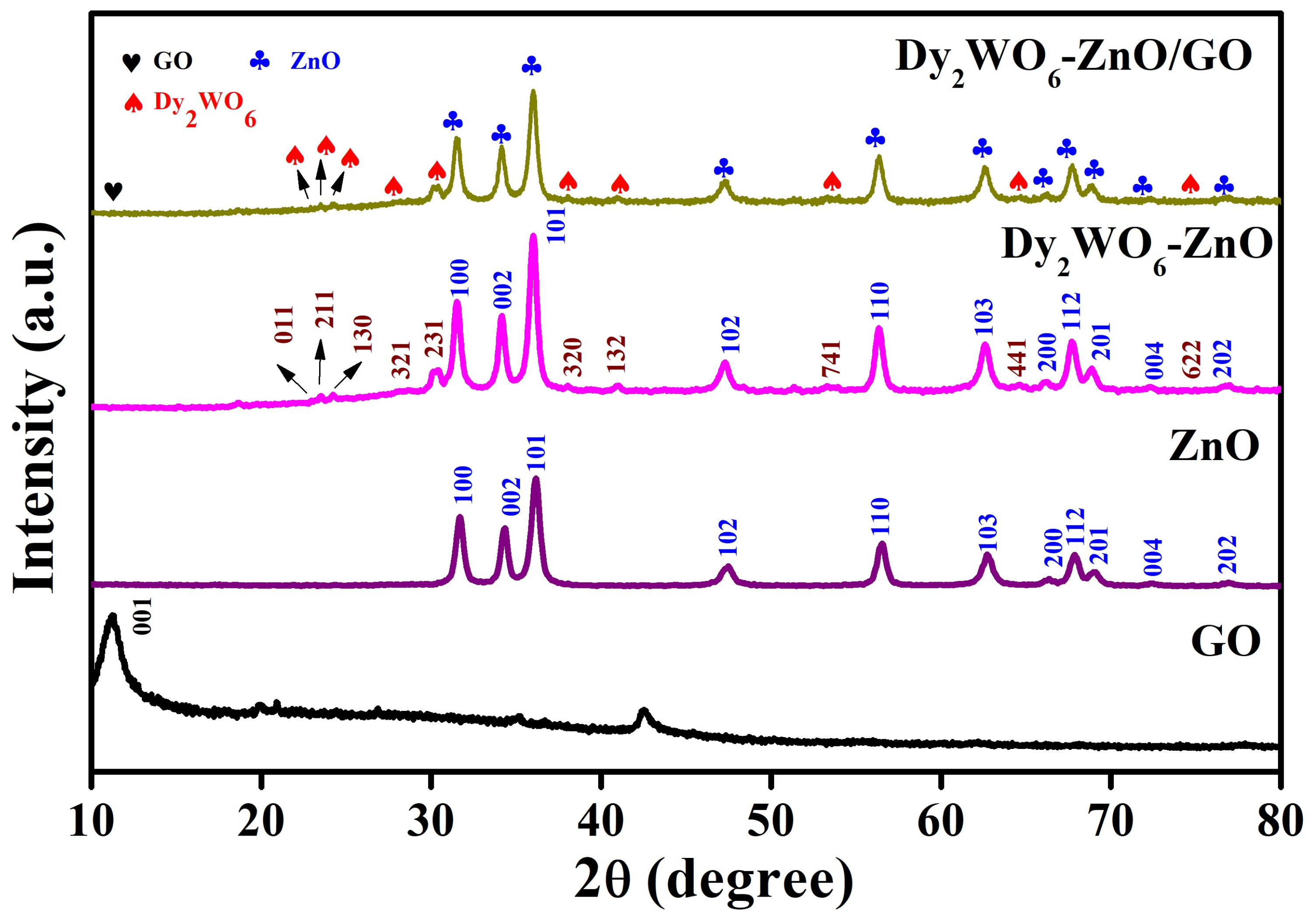
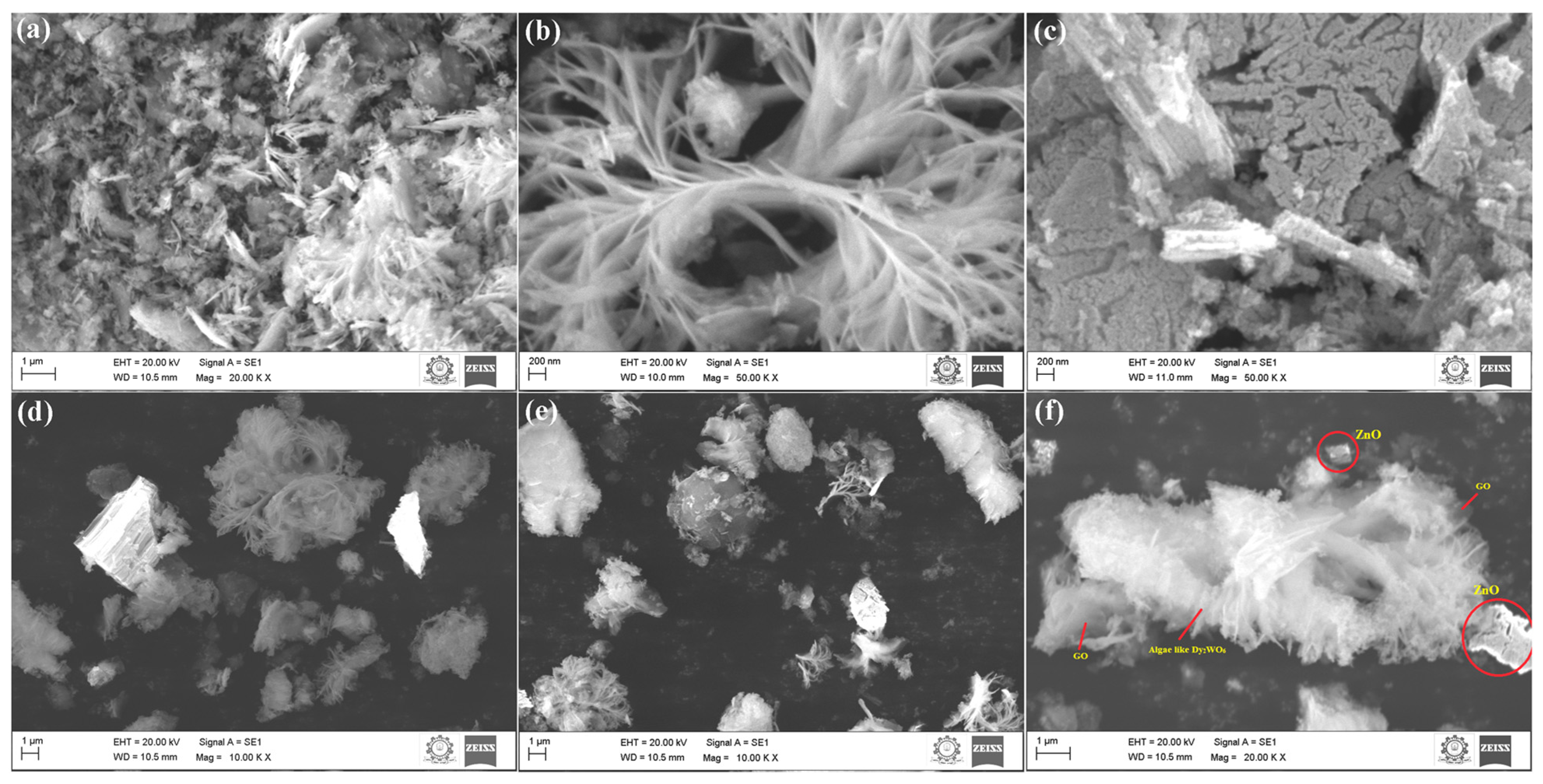
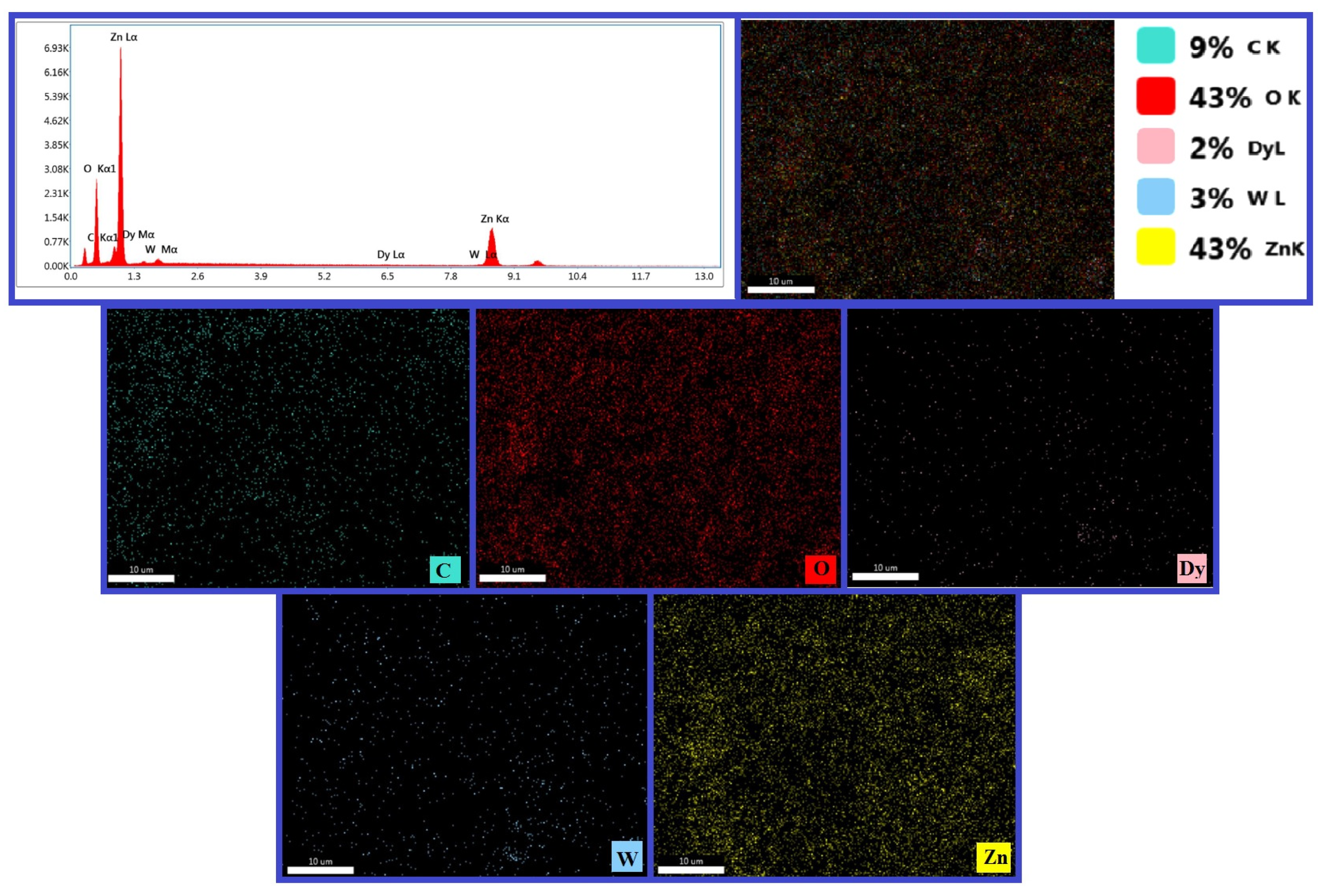
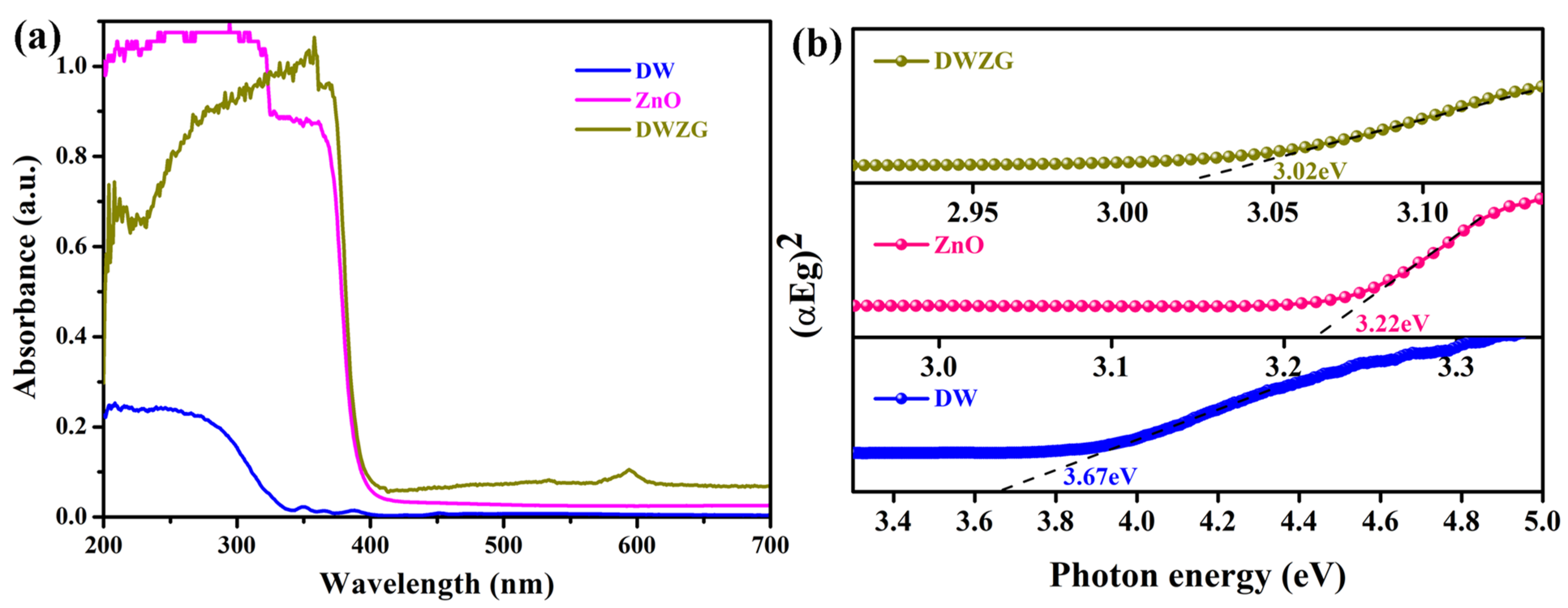
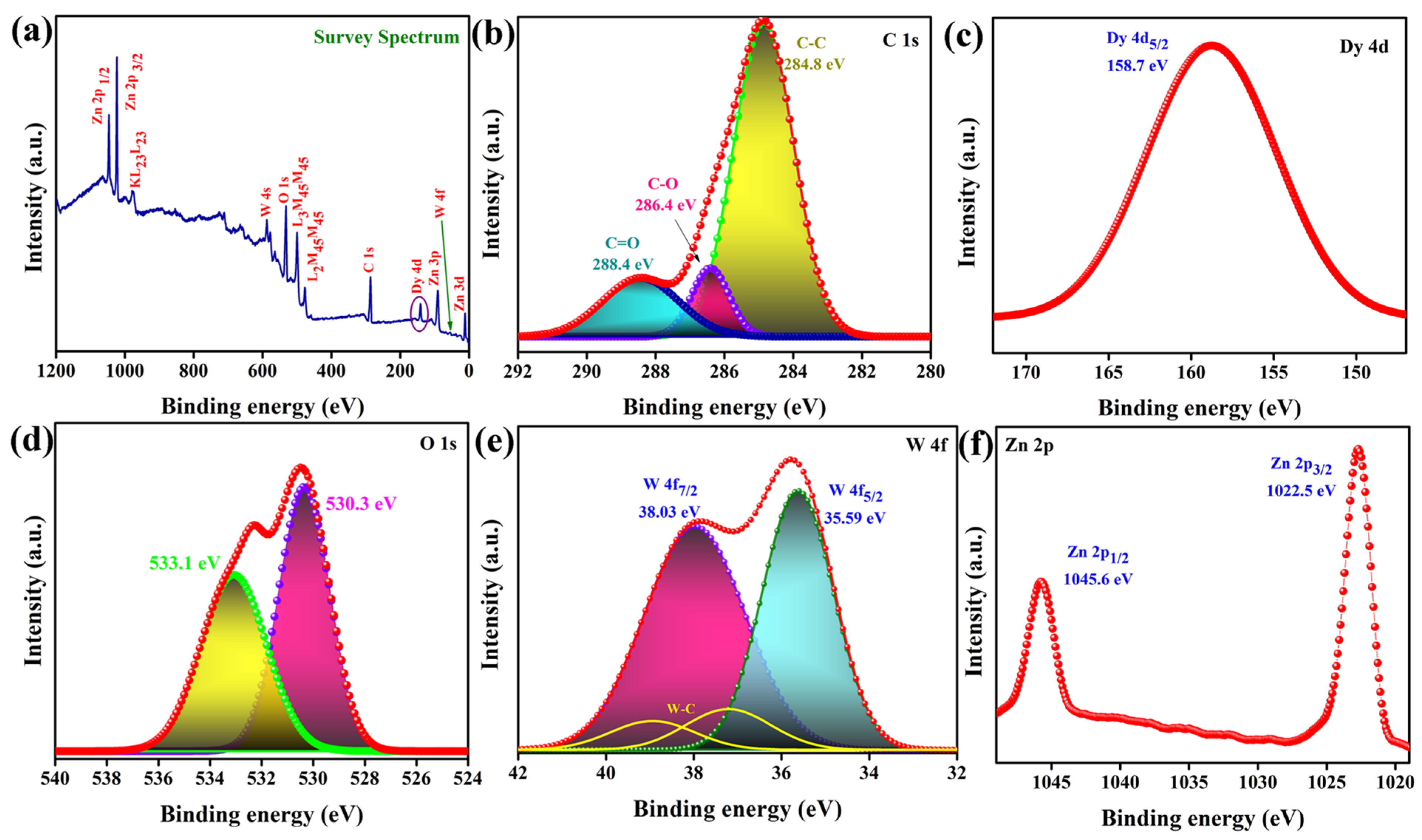


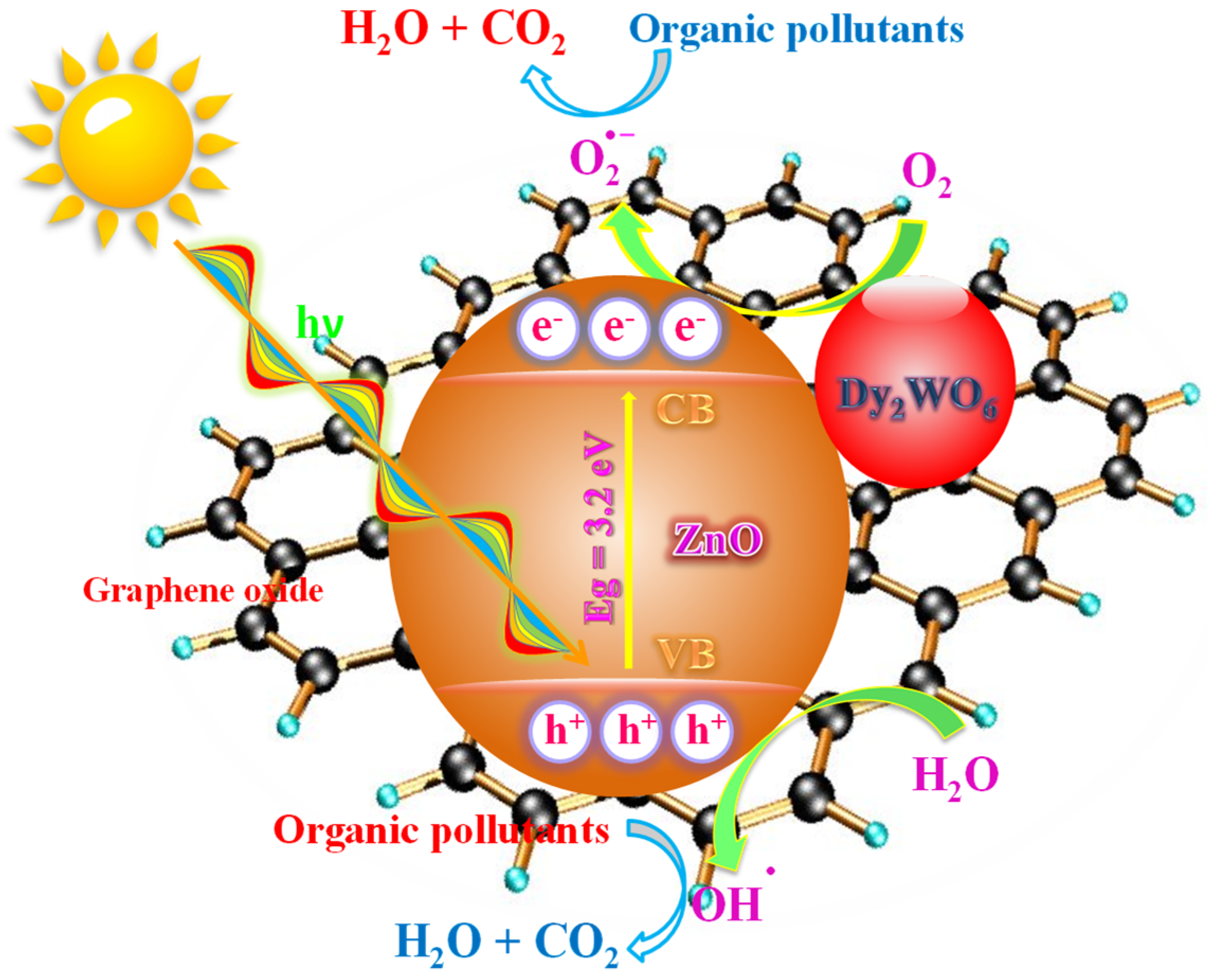
Disclaimer/Publisher’s Note: The statements, opinions and data contained in all publications are solely those of the individual author(s) and contributor(s) and not of MDPI and/or the editor(s). MDPI and/or the editor(s) disclaim responsibility for any injury to people or property resulting from any ideas, methods, instructions or products referred to in the content. |
© 2023 by the authors. Licensee MDPI, Basel, Switzerland. This article is an open access article distributed under the terms and conditions of the Creative Commons Attribution (CC BY) license (https://creativecommons.org/licenses/by/4.0/).
Share and Cite
Selvakumar, K.; Oh, T.H.; Arunpandian, M.; Aruchamy, K.; Polisetti, V. Hydrothermal Fabrication of GO Decorated Dy2WO6-ZnO Ternary Nanocomposites: An Efficient Photocatalyst for the Degradation of Organic Dye. Appl. Sci. 2023, 13, 7145. https://doi.org/10.3390/app13127145
Selvakumar K, Oh TH, Arunpandian M, Aruchamy K, Polisetti V. Hydrothermal Fabrication of GO Decorated Dy2WO6-ZnO Ternary Nanocomposites: An Efficient Photocatalyst for the Degradation of Organic Dye. Applied Sciences. 2023; 13(12):7145. https://doi.org/10.3390/app13127145
Chicago/Turabian StyleSelvakumar, Karuppaiah, Tae Hwan Oh, Muthuraj Arunpandian, Kanakaraj Aruchamy, and Veerababu Polisetti. 2023. "Hydrothermal Fabrication of GO Decorated Dy2WO6-ZnO Ternary Nanocomposites: An Efficient Photocatalyst for the Degradation of Organic Dye" Applied Sciences 13, no. 12: 7145. https://doi.org/10.3390/app13127145




